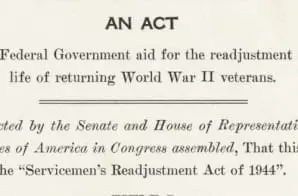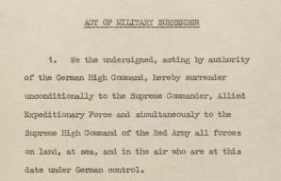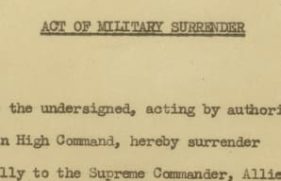Signed into law by President Franklin D. Roosevelt on June 22, 1944, the Servicemen’s Readjustment Act provided World War II veterans with funds for college education, unemployment insurance, and housing. Also known as the G.I. Bill of Rights, it put higher education within the reach of millions of veterans of WWII and later military conflicts.
While World War II was still being fought, the Department of Labor estimated that, after the war, 15 million men and women who had been serving in the armed services would be unemployed. To reduce the possibility of postwar depression brought on by widespread unemployment, the National Resources Planning Board, a White House agency, studied postwar manpower needs as early as 1942. In June 1943, they recommended a series of programs for education and training.
The American Legion designed the main features of what became the Serviceman’s Readjustment Act and pushed it through Congress. The bill unanimously passed both chambers of Congress in the spring of 1944. President Franklin D. Roosevelt signed it into law on June 22, 1944, just days after the D-day invasion of Normandy.
American Legion publicist Jack Cejnar called it “the GI Bill of Rights,” as it offered Federal aid to help veterans adjust to civilian life in the areas of hospitalization, purchase of homes and businesses, and especially, education. This act provided tuition, subsistence, books and supplies, equipment, and counseling services for veterans to continue their education in school or college.
Within the following seven years, approximately eight million veterans received educational benefits. Under the act, approximately 2,300,000 attended colleges and universities, 3,500,000 received school training, and 3,400,000 received on-the-job training. The number of degrees awarded by U.S. colleges and universities more than doubled between 1940 and 1950, and the percentage of Americans with bachelor degrees, or advanced degrees, rose from 4.6 percent in 1945 to 25 percent a half-century later.
Unfortunately, not all veterans were able to take advantage of the benefits of the G.I. Bill. Black vets were often unable to get bank loans for mortgages in Black neighborhoods, and they faced prejudice and discrimination that overwhelming excluded them from buying homes in “white” suburban neighborhoods.
By 1956, when it expired, the education-and-training portion of the GI Bill had disbursed $14.5 billion to veterans—but the Veterans Administration estimated the increase in Federal income taxes alone would pay for the cost of the bill several times over. By 1955, 4.3 million home loans had been granted, with a total face value of $33 billion.
In addition, veterans were responsible for buying 20 percent of all new homes built after the war. The results rippled through the rest of the economy; there would be no new depression—just unparalleled prosperity for a generation. The GI Bill has been extended several times. Nearly 2.3 million veterans participated in the program during the Korean War era and more than eight million during the Vietnam era.
The Servicemen’s Readjustment Act is a part of America’s 100 Docs, an initiative of the National Archives Foundation in partnership with More Perfect that invites the American public to vote on 100 notable documents from the holdings of the National Archives. Visit 100docs.vote today.




